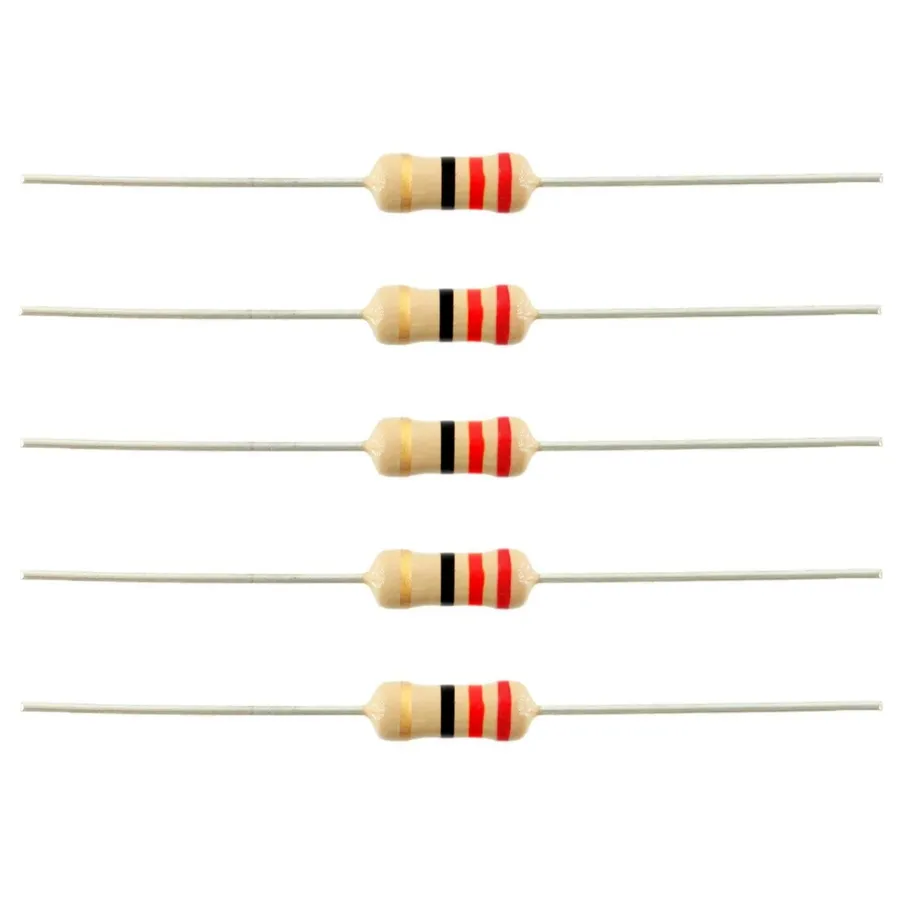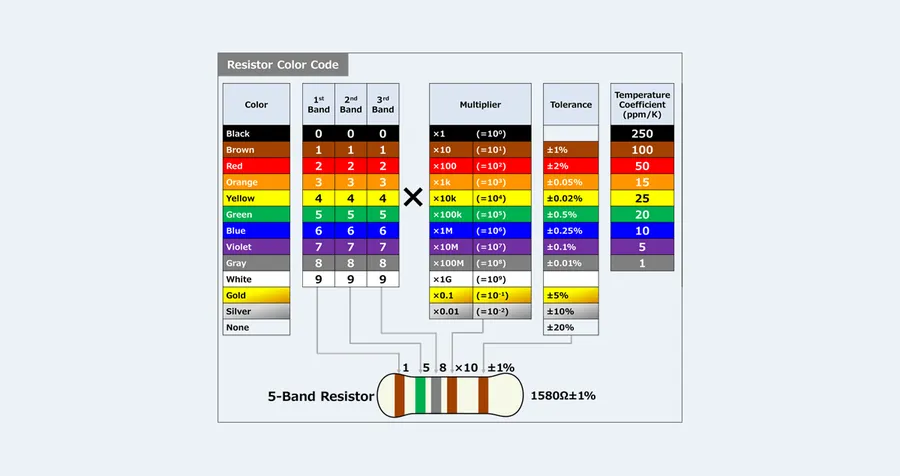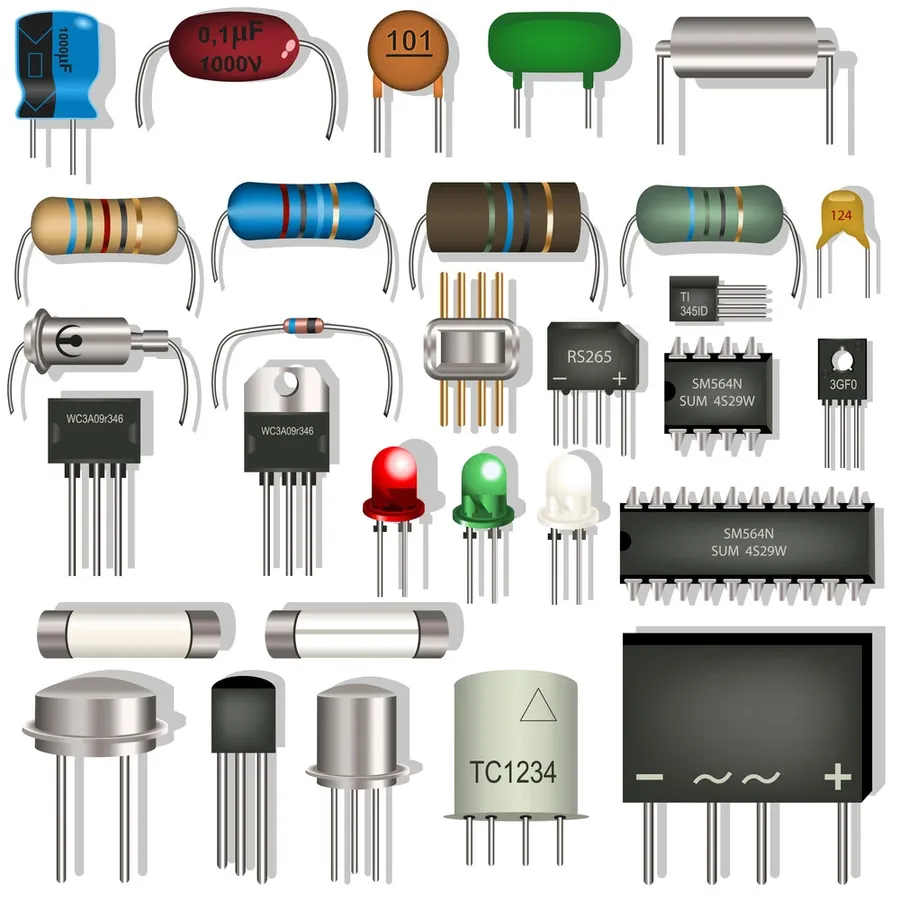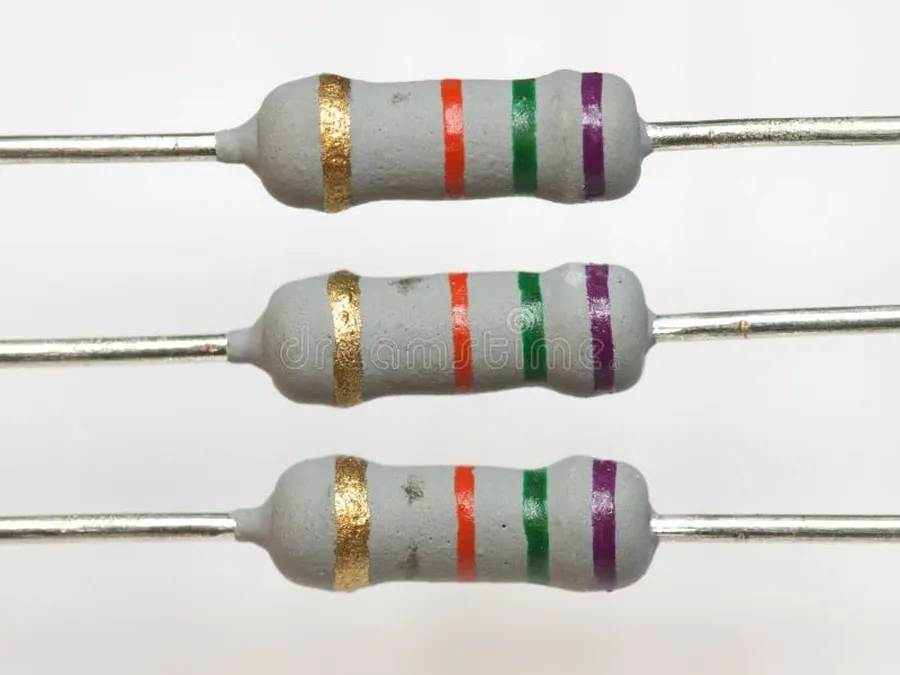Understanding the 22 Ohm Resistor: Applications and Selection

In the world of electronics, the 22 ohm resistor plays a small but critical role, much like a hidden gear in a complex machine. From simple LED circuits to intricate audio equipment, this component is essential for controlling current and protecting sensitive parts. This article demystifies the 22 ohm resistor, exploring its various types, applications, and how it fits within the broader landscape of electrical engineering.
What is a 22 Ohm Resistor?

A 22 ohm resistor is a fundamental passive electronic component that opposes the flow of electrical current, exhibiting a resistance value of 22 ohms. This specific resistance value plays a critical role in various circuit functions, influencing current magnitude, voltage distribution, and overall circuit behavior. Its characteristics, such as color code, physical dimensions, power rating, and tolerance, are crucial parameters that directly affect its application and performance.
The Role of a 22 Ohm Resistor in Circuits

A 22 ohm resistor, like all resistors, fundamentally serves to impede the flow of electrical current within a circuit. This specific resistance value plays a crucial role in current regulation, voltage division, and creating controlled voltage drops, enabling precise circuit behavior and component protection.
The following sections provide a detailed explanation of how a 22 ohm resistor achieves these functions:
- Current Limitation:
By presenting a 22 ohm barrier to current flow, it restricts the amount of current that can pass through a specific part of the circuit. This is critical to prevent damage to components with lower current tolerance, such as LEDs and sensitive integrated circuits. - Voltage Division:
When used in series with other resistors, a 22 ohm resistor creates a voltage divider. The voltage is shared across the resistors, and the voltage drop across the 22 ohm resistor is determined by its resistance relative to the other components, which allows for creation of precise voltage references for operational amplifiers and other analog circuits. - Creating Voltage Drops:
The voltage across a resistor is directly proportional to the current flowing through it according to Ohm's Law (V=IR). A 22 ohm resistor can be used to create a specific voltage drop in a circuit by appropriately selecting the current to pass through it. This is vital in situations that require biasing or adjusting operating points in amplifiers or sensors.
| Function | Description | Application Example |
|---|---|---|
| Current Limitation | Restricts current flow to protect components | LED current limiting circuit |
| Voltage Division | Creates a specific voltage drop | Biasing circuit for a transistor |
| Voltage Drop Creation | Provides a controlled voltage drop | Signal conditioning circuitry |
Different Types of 22 Ohm Resistors

22 ohm resistors are not monolithic; they come in a variety of types, each engineered with specific materials and manufacturing processes to meet diverse application requirements. The choice of resistor type directly impacts performance parameters such as precision, temperature stability, and power handling capacity, all of which are crucial for optimal circuit design.
| Resistor Type | Material | Typical Tolerance | Temperature Stability | Power Handling | Applications |
|---|---|---|---|---|---|
| Carbon Film | Carbon film deposited on a ceramic substrate | ± 5% | Moderate | Low to Medium | General-purpose applications, hobby electronics |
| Metal Film | Thin metal film deposited on a ceramic substrate | ± 1% | Good | Low to Medium | Precision applications, audio circuits |
| Metal Oxide | Metal oxide film deposited on a ceramic substrate | ± 2-5% | Good to High | Medium | High temperature and high voltage circuits |
| Wirewound | Resistive wire wound around a ceramic or fiberglass core | ± 0.1-5% | Very Good | High | High power applications, current sensing |
Understanding Resistor Color Codes: Identifying 22 Ohm

The color code on a 22 ohm resistor is crucial for quick identification, it is typically represented by a series of colored bands. These bands correspond to a numerical value. The standard for reading these bands is from left to right, with the first two bands representing the resistance value, the third band acts as a multiplier, and the fourth band usually indicates tolerance.
| Band | Color | Value | Multiplier | Tolerance |
|---|---|---|---|---|
| 1st Band | Red | 2 | - | - |
| 2nd Band | Red | 2 | - | - |
| 3rd Band | Black | - | 10^0 (or 1) | - |
| 4th Band | Gold | - | - | ± 5% |
| 4th Band | Brown | - | - | ± 1% |
For a 22 ohm resistor, the typical color bands are Red, Red, Black and either Gold (for 5% tolerance) or Brown (for 1% tolerance). The bands should be interpreted as follows: the first red band represents the digit 2, the second red band also represents the digit 2, and the black band indicates a multiplier of 1 (10^0). The gold band indicates a tolerance of ±5%, while the brown band indicates a tolerance of ±1%.
Common Applications of a 22 Ohm Resistor

The 22 ohm resistor, with its specific resistance, is employed in a range of applications where controlled current flow and voltage manipulation are critical. Its precise value makes it well-suited for tasks like current limiting, transient suppression, and audio signal management.
- LED Current Limiting
A primary application is limiting current flowing through Light Emitting Diodes (LEDs). Without a current-limiting resistor, LEDs can draw excessive current, leading to damage or premature failure. The 22 ohm resistor provides an effective way to regulate this current for optimal LED performance and longevity. - Snubber Circuits
22 ohm resistors are used in snubber circuits, which are employed to suppress transient voltages in circuits, particularly when inductive loads are switched. This reduces unwanted electromagnetic interference (EMI) and protects sensitive components. - Audio Signal Conditioning
In audio circuits, 22 ohm resistors play a role in signal conditioning and impedance matching. They help maintain signal integrity and prevent reflections that can cause distortion or signal loss. This is often used in amplifier circuits or signal transmission lines. - Impedance Matching
The 22 ohm resistor can serve as a matching impedance in some low-impedance applications, usually on audio, video and other signal transmission lines. Impedance matching is crucial to maximizing power transfer and preventing signal reflections. A 22 Ohm impedance can be a standard requirement in some low-impedance transmission applications.
Power Rating and Tolerance: Key Considerations for a 22 Ohm Resistor

Selecting the correct 22 ohm resistor necessitates a thorough understanding of its power rating and tolerance, as these parameters directly influence the resistor's performance and reliability within a circuit. The power rating dictates the maximum power the resistor can dissipate without being damaged, while tolerance defines the allowable deviation of its actual resistance from the nominal 22-ohm value.
| Parameter | Description | Impact on Performance | Selection Considerations |
|---|---|---|---|
| Power Rating (Watts) | The maximum power a resistor can dissipate as heat without failure. | Insufficient power rating can lead to overheating, resistor failure, and potential damage to the circuit. A higher power rating will result in a physically larger and potentially more expensive component. | Calculate the maximum power dissipation in the circuit, and select a resistor with a power rating substantially higher, typically at least double the calculated power, to ensure a safety margin. |
| Tolerance (%) | The allowable percentage deviation of the actual resistance value from the nominal 22 ohms. | Higher tolerance (e.g., 5% or 10%) results in greater variability in the actual resistance, which might not be suitable for precision applications. Lower tolerance (e.g., 1% or 0.1%) ensures a more precise resistance value, which could be critical for highly accurate applications. | For applications requiring high accuracy and stability choose resistors with low tolerance. Common applications use 5% tolerance, but precise circuits might require 1% or even 0.1%. |
Frequently Asked Questions About 22 Ohm Resistors
This section addresses common inquiries regarding 22 ohm resistors, focusing on their appropriate utilization in various circuits and the consequences of improper application. Understanding these aspects is crucial for effective circuit design and troubleshooting.
- What is the primary function of a 22 ohm resistor in a circuit?
A 22 ohm resistor's primary function is to limit current flow to a specific level, according to Ohm's Law. This is essential for protecting components from excessive current and managing voltage drops in various circuit configurations. - What is the color code for a 22 ohm resistor?
The standard color code for a 22 ohm resistor is typically Red, Red, Black, and Gold (for 5% tolerance), or Red, Red, Black, Brown (for 1% tolerance). The first two bands represent the numerical value (2 and 2), the third band is the multiplier (10^0 = 1), and the fourth band signifies the tolerance. - What is the difference between a 22 ohm resistor and a 22K ohm resistor?
A 22 ohm resistor has a resistance of 22 ohms, while a 22K ohm resistor has a resistance of 22,000 ohms (22 kilo-ohms). The 'K' denotes a multiplier of 1000, indicating a significantly higher resistance value and thus different behavior in a circuit. Therefore, these two resistors cannot be used interchangeably. - What does a '22R' designation mean for a resistor?
The notation '22R' simply means a 22 ohm resistor, where 'R' is used in place of the Ohm symbol (Ω). This is commonly used in marking components and schematics when the use of the symbol is not feasible. - What happens if I use a 22 ohm resistor in an application where a different value is required?
Using a 22 ohm resistor where a different value is required could lead to improper circuit operation. For example, if a higher value resistor is needed, a 22-ohm resistor will allow too much current to pass, potentially damaging other components or causing the circuit to malfunction. Conversely, if a lower value is needed, it will impede the current flow more than intended, also resulting in circuit malfunction. - Can a 22 ohm resistor be used as a fuse?
While a 22 ohm resistor might fail if subjected to excessive current, it is not designed to function as a fuse. Fuses are specifically designed to break a circuit at a defined current level to protect other components from damage due to overcurrent. A resistor's failure mode may not be predictable or fail safe compared to a dedicated fuse. It should not be considered a suitable substitute. - How does the power rating of a 22 ohm resistor affect its performance?
The power rating of a 22 ohm resistor indicates how much power it can dissipate as heat without damage. If the power dissipated exceeds its rating, the resistor can overheat, leading to failure. Therefore, it's crucial to select a resistor with a power rating sufficient for the application to ensure long-term reliability and stable circuit operation. Exceeding power ratings is a common source of resistor failure.
How to Choose the Right 22 Ohm Resistor for Your Project

Selecting the appropriate 22 ohm resistor for a project requires a balanced approach considering the electrical demands and environmental conditions. This involves assessing the circuit's current, voltage, and the application's operating environment.
- Determine the Power Dissipation:
Calculate the power the resistor will dissipate using the formula P = I²R, where P is power in watts, I is current in amps, and R is resistance in ohms. Select a resistor with a power rating significantly higher than calculated to avoid overheating and premature failure. A good rule of thumb is to use a resistor with at least twice the calculated power rating. - Consider Physical Size and Type:
Resistors come in various sizes and types, such as surface-mount (SMD) and through-hole. SMD resistors are compact, and are used for high-density circuits while through-hole resistors are easier for prototyping and manual assembly. Choose the type based on your application. Also take into consideration the power that is to be dissipated by the resistor when considering the size. - Assess Tolerance Needs:
The tolerance of a resistor indicates the allowable deviation from its nominal resistance value. Standard tolerances are typically 5%, 1%, or 0.1%. A tighter tolerance is necessary for precise applications like instrumentation or precision signal conditioning circuits. For less critical applications such as LED current limiting, a higher tolerance will suffice. - Evaluate Temperature Coefficient:
The temperature coefficient describes the change in resistance due to variations in temperature. For applications where the circuit is subjected to extreme temperature fluctuations, a resistor with a low temperature coefficient is essential to maintain a consistent performance. Metal film resistors are known for better temperature stability. - Choose the Correct Resistor Technology:
Resistor construction types like carbon film, metal film, and wirewound offer different characteristics, such as temperature stability, precision, and power capacity. Metal film resistors offer high precision and temperature stability and are preferred for precision applications. Wirewound resistors are more robust and capable of dissipating high amounts of power and would be better suited for power applications.
22 Ohm Resistor vs. Other Resistor Values: When to Use Which
The selection of a resistor value is paramount in circuit design, with the 22 ohm resistor being a common but not universally applicable choice. This section delves into the distinctions between a 22 ohm resistor and other values, providing insight into when to utilize a 22 ohm resistor and when alternative values are more appropriate for optimizing circuit performance.
| Resistor Value | Typical Application Scenarios | Advantages | Disadvantages |
|---|---|---|---|
| 22 Ohm | LED current limiting, signal conditioning, snubber circuits | Precise current control, suitable for specific impedance matching | May not be ideal for high current applications due to lower resistance value. |
| 1 Ohm - 10 Ohm | Current sensing, low-value shunt resistors | Minimal impact on the circuit, can measure large currents with minimal voltage drop | May be insufficient for high current limiting requirements. |
| 100 Ohm - 1K Ohm | Pull-up/pull-down resistors, basic current limiting, voltage dividers | Versatile for basic digital logic and signal control applications. | May not provide enough precision for certain applications that require exact impedance matching. |
| 10K Ohm - 1M Ohm | Feedback resistors in op-amp circuits, bias resistors, high-impedance sensing | Low current consumption, high impedance for sensitive measurements | May not be suitable for high current applications or impedance matching in certain circuit types. |
| Values Above 1M Ohm | Extremely high impedance circuits, specialized sensor applications | Reduces current drain and allows for precise measurement of very low signals | Susceptible to noise, may not be suitable in high-noise environments. |
In summary, the 22 ohm resistor serves a specific purpose when moderate current control and impedance are required. It is crucial to evaluate your design requirements to choose the best value of resistor needed for your circuit.
The 22 ohm resistor is a workhorse in electronics, crucial for managing current, and voltage in a diverse range of circuits. Whether it's for lighting up LEDs or ensuring optimal audio quality, understanding its properties and applications is essential for anyone working with electronics. The correct selection of a 22 ohm resistor, like other electronic parts, is key to a successful project. From color codes to power rating, each aspect plays a role in the final circuit.
 AnyPCBA
AnyPCBA